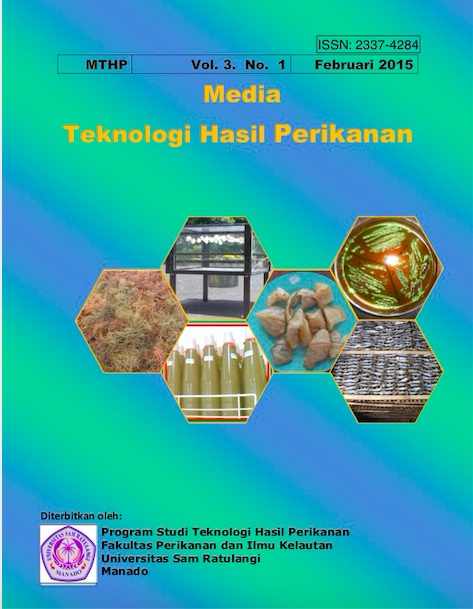TINGKAT KESUKAAN PADA STEAK IKAN CAKALANG (Katsuwonus pelamis L.) YANG DIRENDAM DALAM ASAP CAIR
DOI:
https://doi.org/10.35800/mthp.3.1.2015.8326Keywords:
Tuna, Katsuwonus pelamis L., liquid smoke, pH and appearance quality, Cakalang, asap cair, uji mutu pH dan organoleptikAbstract
Fogging is one way of preserving fish processing functions as well as providing odor as well as a simple way and has weaknesses. To over come these weaknesses, it can be attempted use of liquid smoke. The purpose of this study was to determine the level of preference of panelists and sticks pH value tuna mariheted in luquit smoke and followed by drying in an oven, the level of consumer preference were examined induced, appearance, odor, taste and consistency. The results were obtained of the average value pH sticks tuna were soaked in liquit smoke concentrations of 40% (A1), 5,52 and a concentrations of 50% (A2), 5,54 where as the concentrations of 60% (A3) is 5,31. Organoleptic appearance obtained average value is the concentration of 40% is 5,76, whereas the concentration of 50% 6,39, 60%, 6,7. Organoleptic odor obtained an average value of 40%, was 5,19, the concentration of 50%, 5,93, whereas the concentrations of 60%, 5,86. Organoleptic taste obtained average concentrations value of 40%, 5,63, concentration 50% 7,23 and the concentrations of 60% is 7,10. Concistency test gained an average of 40%, 5,76 concentrations of 50%, 6,83 whereas concentrations of 60%, 6,36. Based on research results pH value test and organolptic test at level a tuna fish sticks, are soaked in liquit smoke has a low pH value, organoleptic, odor,appearance, consistencyhas an average value below 6, while the value of the taste test average value above 7,found in concentrations of 50% 7,23 and concentrations 60% values of 7,10.
Â
Keywords: Tuna (Katsuwonus pelamis L.). liquid smoke, pH and appearance quality.
Â
Â
Pengasapan merupakan salah satu cara pengolahan ikan yang berfungsi mengawetkan serta memberikan aroma dengan cita rasa yang khas. Produk olahan ini masih bersifat tradisional karena masih menggunakan cara sederhana dan memiliki kelemahan-kelemahan. Untuk mengatasi kelemahan tersebut, maka dapat di upayakan penggunaan Asap Cair.      Tujuan dari penelitian ini adalah untuk mengetahui tingkat kesukaan panelis dan nilai pH steak cakalang yang direndam dalam asap cair dan dilanjutkan dengan pengeringan dalam oven, tingkat kesukaan konsumen yang diteliti meliputi : kenampakan, Bau, Rasa dan Konsistensi. Hasil penelitian diperoleh untuk nilai rata-rata pH steak Ikan Cakalang yang direndam Dalam Asap Cair konsentrasi 40% (A1), 5,52 dan konsentrasi 50% (A2), 5,54 sedangkan konsentrasi 60% (A3), adalah 5,31. Uji Organoleptik kenampakan diperoleh nilai rata-rata yaitu konsentrasi 40%, adalah 5,76, konsentrasi 50%, 6,39 sedangkan 60%, 6,7. Uji Organoleptik Bau diperoleh nilai rata-rata konsentrasi 40%, 5,19, konsentrasi 50%, 5,93 sedangkan kosentrasi 60%, 5,86. Uji Organoleptik Rasa diperoleh nilai rata-rata kosentrasi 40%, 5,63 konsentrasi 50%, 7,23 dan konsentrasi 60%, 7,10. Uji Organoleptik Kosistensi diperoleh nilai rata-rata 40%, 5,76, kosentrasi 50%, 6,83 sedangkan kosentrasi 60%, 6,36. Berdasarkan hasil penelitian Uji nilai pH dan Uji Organoleptik Tingkat Kesukaan pada Steak Cakalang yang direndam dalam Asap Cair memiliki nilai pH yang rendah, Uji Organoleptik Bau. Kenampakan, Kosnsistensi memiliki Nilai rata-rata di bawah 6, sedangkan untuk Nilai Uji Rasa Nilai rata-rata di atas 7, terdapat pada Konsentrasi 50% dengan Nilai 7,23 dan Konsentrasi 60% Nilai 7,10.
Â
Kata kunci: Ikan Cakalang (Katsuwonus pelamis L.), asap cair, uji mutu pH dan organoleptik.
Downloads
Published
How to Cite
Issue
Section
License
Authors who publish with this journal agree to the following terms:
- Authors retain copyright and grant the journal right of first publication with the work simultaneously licensed under a Creative Commons Attribution License that allows others to share the work with an acknowledgement of the work's authorship and initial publication in this journal.
- Authors are able to enter into separate, additional contractual arrangements for the non-exclusive distribution of the journal's published version of the work (e.g., post it to an institutional repository or publish it in a book), with an acknowledgement of its initial publication in this journal.
- Authors are permitted and encouraged to post their work online (e.g., in institutional repositories or on their website) prior to and during the submission process, as it can lead to productive exchanges, as well as earlier and greater citation of published work (See The Effect of Open Access).







